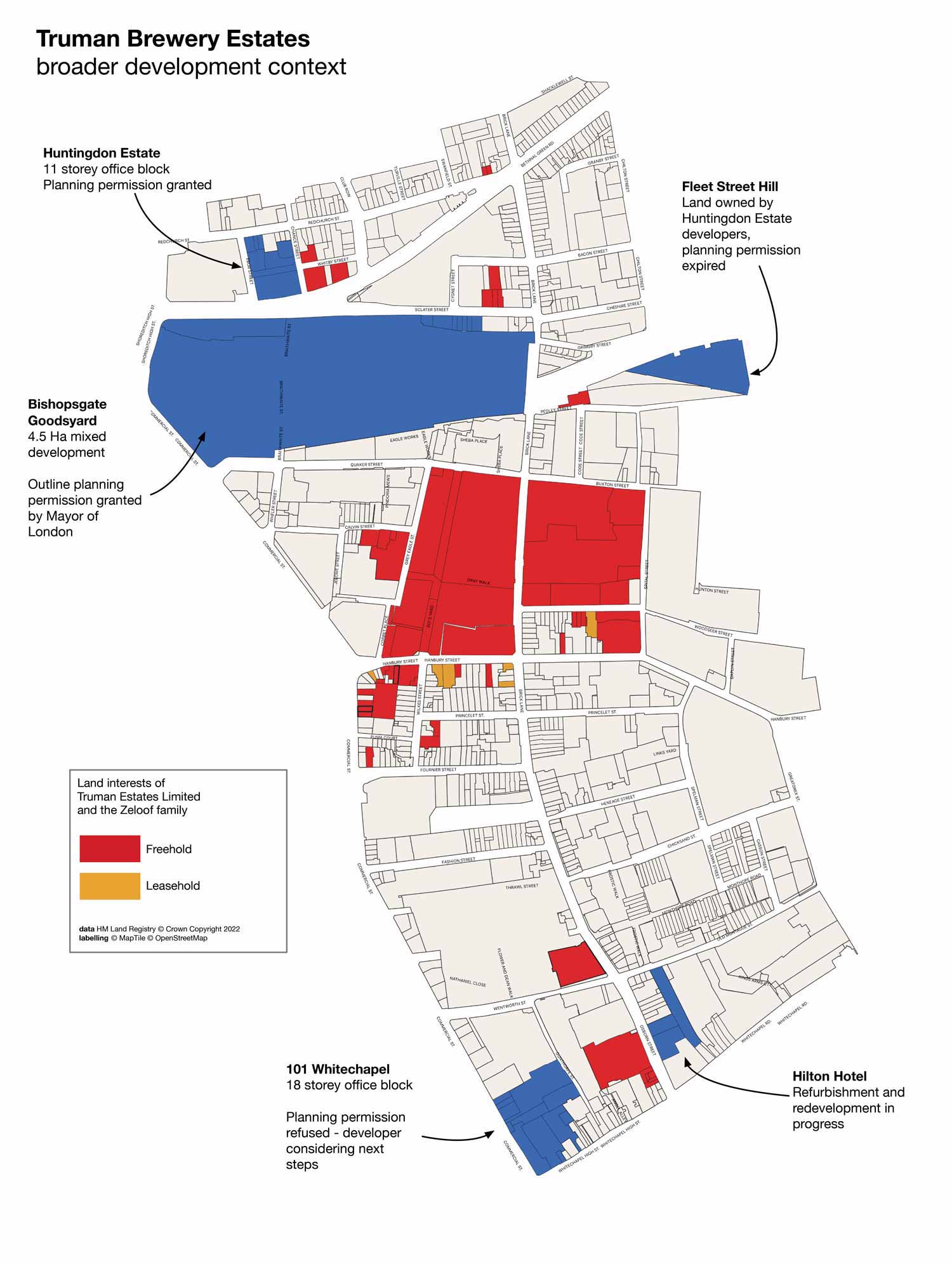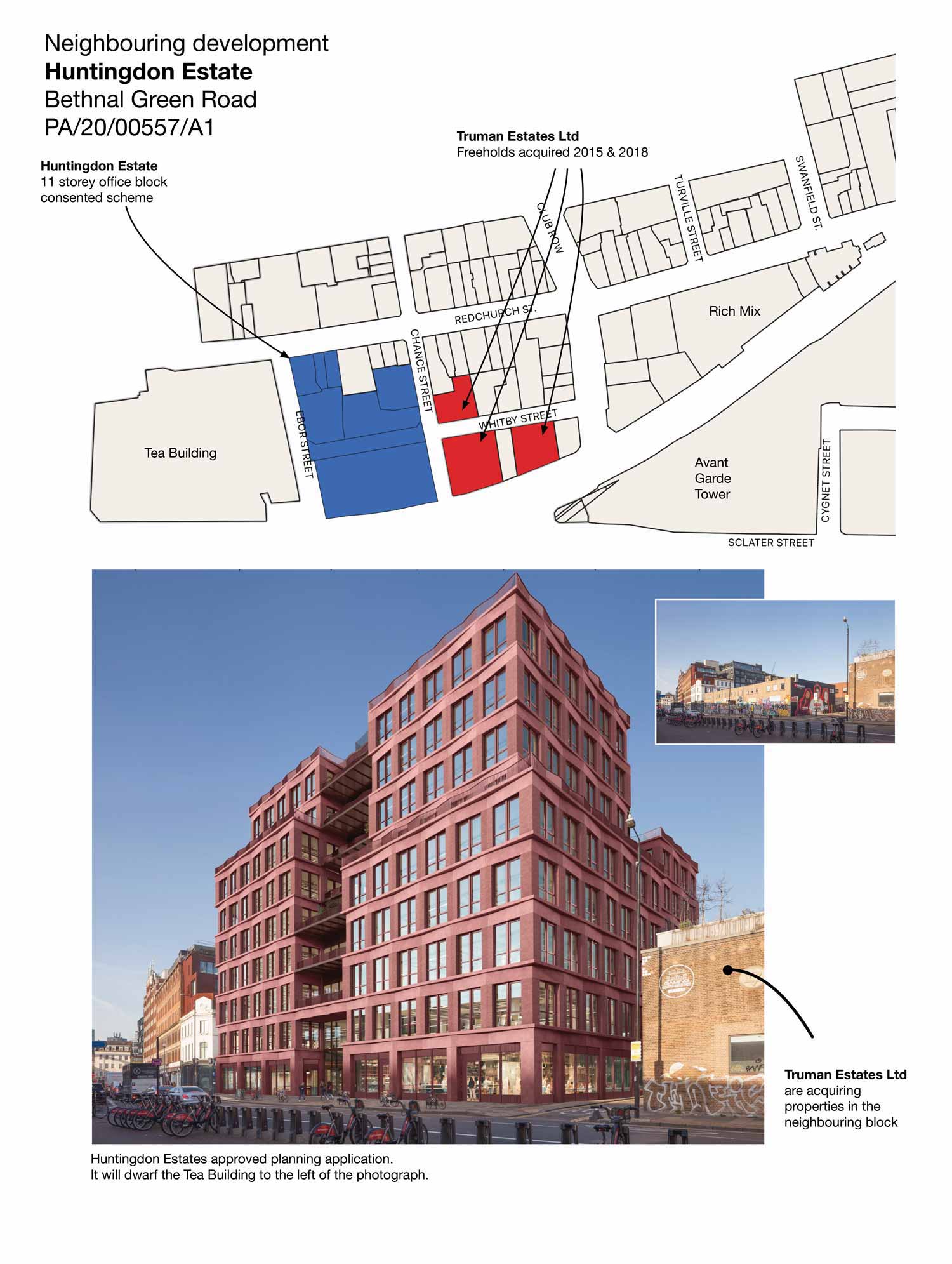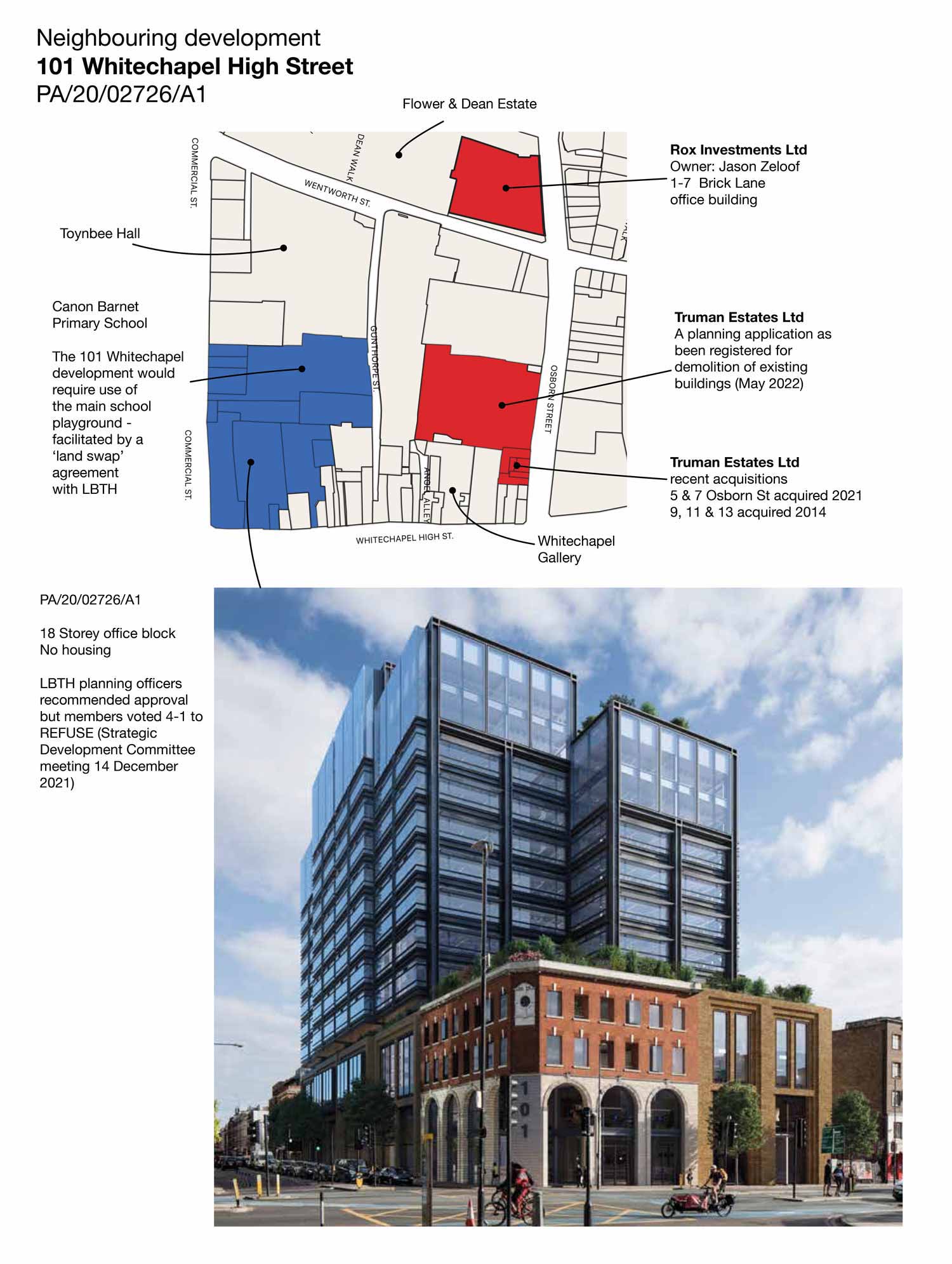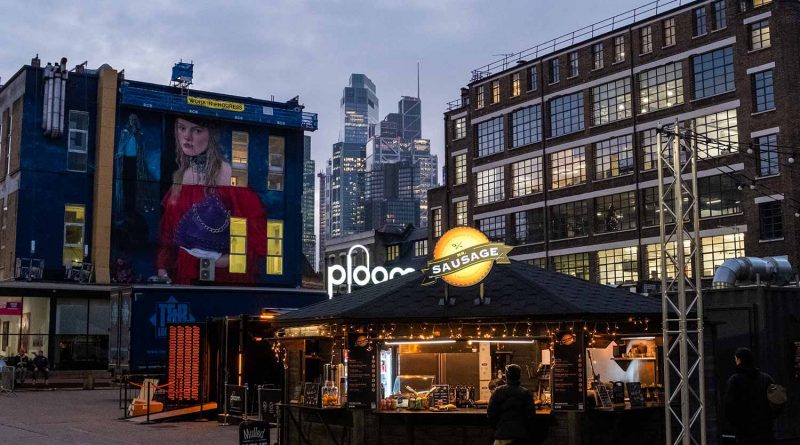Empire builders: The Brick Lane property portfolio of Truman Estates Ltd and its power to alter the fabric of the East End
In the previous four articles of our series looking into the unpopular Truman Brewery development, we have seen how the community came together to fight the proposal, shone a light on the pro-development culture within the Council, revealed how the Neighbourhood Plan set up to protect the community of Brick Lane was thwarted, and learned about the family behind the development as well as the off-shore company that owns the majority of the brewery land.
In our fifth and final article, we reveal that the Truman Brewery development is only the first in a raft of planned developments linked to the Truman Brewery Estate. Read the fourth article here.
The controversial Truman Brewery development, which many fear will turbocharge gentrification in the Brick Lane area, is only the beginning of a slew of developments linked to the brewery owners.
With the help of Deivi Norberg, Doctoral Researcher at Queen Mary University, and data analyst Sam How, we have mapped the landholdings of Truman Estates Ltd, the offshore company set up by the Zeloof family.
Our maps reveal how companies owned by the Zeloof family began amassing strategic plots of land in Spitalfields and Banglatown since their purchase of the brewery in the 1990s.
Since 2014, purchases by Truman Estates Ltd, then owned by the Zeloofs, have increased sharply, with the company buying an additional 32 parcels of land in the surrounding area.
Truman Estates Ltd now owns 56 parcels of land in and around Spitalfields and Banglatown, making it the biggest private landowner in the area.
In 2019, Companies House was notified that the Zeloof family were no longer the owners of Truman Estates Limited. The company was now majority owned by Douglas Ryan, making him the largest private owner of land in the Brick Lane area. Jason Zeloof maintains involvement with Truman Estates Limited through his role as the overall manager of their brewery estate and through his family’s ownership of six parcels of land within the walls of the estate.
This portfolio includes a historic stable yard behind Hanbury Street, directly opposite the revamped Old Spitalfields Market, which now houses luxury boutiques and a gourmet food court alongside its market.
Truman Estates Limited was planning to lease this listed stable yard to Time Out, who had been trying for six years to transform it into one of their ubiquitous Food Markets.
Time Out: Another Food Hall in Spitalfields
The original Time Out plan aimed to construct one of the largest contemporaneous eating and drinking establishments in London and included 17 restaurants, a cooking academy, four bars, a shop, and an art gallery, expecting to attract at least 2,000 visitors to the area a day.
The first application was rejected in 2017 by a sub-licensing committee after a campaign involving 70 objections, a record at the time. Objectors lamented overdevelopment, rising house, and rent prices, potential damage to heritage assets as well as the strangulation of existing local independent businesses.
These objections and the fact that the proposed site lies within a Cumulative Impact Zone (CIZ), an area where local authorities believe the amount of licensed premises in the area is having an adverse impact on community life, were integral to the licensing committee’s refusal.
Time Out appealed the decision in 2018 but their appeal was rejected.
The media giant returned with a revised planning application in July 2022, with two bars and twelve restaurants, instead of seventeen, and proposals to mitigate potential damage to heritage assets. The application has been deferred by the planning committee, after once again triggering mass objections.
This time, influential members of the community, such as Guljar Kahn, chair of the Banglatown Restaurant Association, came out in staunch opposition to the plans.
Kahn, an established businessman who is usually an advocate for all development in the area, attended the latest Time Out application to deliver a stirring speech in resistance to the proposal.
The restaurateur, who grew up locally, argued that the development “would destroy Brick Lane’’ and make it a “ghost town’’, contending that trade had fallen 30-40% in Brick Lane restaurants since “the redeveloped Spitalfields market opened with high-end branded restaurants.’’
“The proposal from Time Out’’ he argued, “is a disaster for Brick Lane itself, the local community, and the culture we have built around us. Our Bangladeshi heritage is threatened by this development… if you approve this scheme you’ll hasten the demise of Bangla culture that makes Tower Hamlets so distinctive.’’
This new food hall would be ‘’no substitute for local community-led building’’ Kahn concluded.
Food halls are opening throughout the city, from Brixton to Broadgate. They are the dream for landlords like Truman Estates Ltd as they have the potential to increase the value of both their property and surrounding rents.
A Guardian article recently labelled food halls “engines of gentrification” noting how they are “cropping up in areas such as Deptford and Brixton and Peckham at the same moment they become real-estate hotspots.’’
The arrival of trendy food halls has encouraged property speculators to raise rent prices in the areas surrounding them, and in so doing, price out existing residents throughout working-class London, from Deptford to Finsbury Park.
An article in the Brixton Blog laments the damage done to Brixton’s embedded, predominantly Black and Caribbean community by the arrival of food hall complexes, arguing that “the arrival of a hot new food market has so far been a guarantee of social cleansing, Council tenant evictions and a feast for property speculators.’’
If we are to go by the effect food halls have had on working-class communities in London over the last few years, another corporate-owned food hall in Spitalfields would have spelled disaster for Brick Lane’s existing working-class community while further increasing the value of Truman Estates Ltd’s landholdings.
In February of this year, TimeOut withdrew its plans, “With an expectation of the process being drawn out by further delays we have decided to no longer proceed with our application but focus our resources on other opportunities.”
They went on to thank the would-be facilitators of the market, “We are grateful to everyone who has supported us throughout this process, in particular the landlord, Truman Brewery.”
The nature of the development that will take place on the site following TimeOut’s withdrawal is now uncertain.
Further plans on Brick Lane

Truman Estates Ltd has plans to develop another site in the northeast of the brewery, adjacent to the commercial complex that has already been approved.
The planning application for the office block assures the Council that the proposed scheme would “enhance the character and appearance of the Brick Lane and Fournier Street Conservation Area and would preserve the setting of nearby listed buildings.”
Yet, in January 2022 the landlords permitted historic Victorian granite paving covering the north-eastern corner of this yard to be unlawfully removed. The need to preserve heritage assets can become an obstacle to development, so removing these would facilitate any future plans Zeloof submits for planning approval.
Truman Estates Ltd also bought three plots of land on Bethnal Green Road between Rich Mix and the Tea Building in 2015 and 2018.
These sites are strategically placed along the corridor of high-rise buildings that have been sweeping eastwards along Bethnal Green Road from the Bishopsgate Goodsyard complex. The controversial skyscraper ‘quarter’ was first dreamed up in 2002 by developers Hammerson and Ballymore, who had acquired the old railway arches from Transport for London.
The sites acquired by the brewery owners directly face the 25-storey Avant Garde Tower and overlook the Huntingdon Industrial Estate, which was recently granted permission (with a one-vote margin) to redevelop the modest two-storey industrial warehouse into a nine-storey office development.

Securing permission for tall buildings overlooking low-rise Conservation Areas such as neighbouring Boundary Estate Conservation Area is nigh on impossible. Unless there is context.
In the planning world ‘context’ relates to the built environment surrounding any given proposed development, meaning any development must tailor itself to the wider setting in which it will be erected.
Since the local community lost the long and bitter battle against the sky-scraping Bishopsgate Goodsyard complex, the floodgates to further high-rise developments have opened.
When the Avant-Garde developers were attempting to have their proposal accepted, they used the argument that the site was on the edge of the high-rise Bishopsgate Goodsyard, providing precedence. Huntingdon Estate also used this argument to get their development passed, citing that, “the building would have an acceptable relationship with neighbouring properties and the emerging context of tall buildings in the area, such as the Bishopsgate Goodsyard scheme…’’.
This “emerging context of tall buildings’’, will make it easier for the Jersey-based company to secure planning permission for any possible future high-rise proposals, in an area fast transforming into another identikit district of glass and steel.
Moving in on Whitechapel
At the opposite end of Brick Lane, near Whitechapel High Street, the brewery owners have made the first overtures toward developing a former warehouse at the bottom of Osborn Street (number two on the map).
In April 2022, Truman Estates Ltd submitted a planning application for the demolition of redundant structures at the Osborn Street site. The company also bought up an additional five parcels of land adjoining the site at the bottom of Osborn Street, a sign that land is being primed for yet another large-scale mega-development.
This pattern is not new to us. In 2014, while seeking approval for the Truman Brewery application on its land, the Jersey-based company purchased multiple properties in and around the proposed site. In 2016, it also purchased several sites around the proposed site of the Time Out market. The company’s ownership has changed, but the management of the estate, and the tactics it uses, have not.
For a company involved in development, the advantage of owning buildings surrounding one of their proposals is that the potential risk of objections is reduced. If the developer is also the landlord in the vicinity of a site being primed for development, their own tenants will be less likely to oppose the plans.
Whether Truman Estates Ltd will be involved in the erection of another mega-development, this time on the site of a former warehouse, is now also contingent on the development context, specifically Alliance Property Asia Incorporated’s plan to erect an office block at 101 Whitechapel High Street, which is marked blue on the map below.

The proposal at 101 Whitechapel High Street included a 14-storey office block. The development was contingent on a land swap deal between adjacent Canon Barnet Primary School and the developers, who needed the space that could have been provided by the school’s playground.
In December 2021, the application was rejected by the Council’s Aspire-led development committee, offering hope to local campaigners that Mayor Lutfur Rahman’s new administration would make a departure from the open arms shown to corporate megadevelopment by the former Labour administration.
Recently, the developers launched an appeal against the decision, which they have now withdrawn since the Canon Barnet School issued an objection.
However, the unrelenting drive for corporate development will almost certainly reassert itself again, with a proposed application expected in the coming months.
If the 14-storey office block at 101 Whitechapel High Street, which is the same height as the 20-storey office block across the road, is eventually accepted upon re-application, Truman Estates Ltd 0.72-acre plot behind Whitechapel Gallery, will be, on account of context, primed for similar scale development.
The site has lain derelict for a long time and has become a hive of anti-social activity so development on the site is welcome by all.
However, it is the form of development that the community will again await with bated breath.
Is there hope with Aspire?
Since time immemorial Brick Lane and its environs have been a refuge beyond the city walls for those unwelcome or unneeded within the city.
The shadow of the street’s past as the first port of call for all seeking refuge still lingers as the narrow street hums in the present.
A Roman burial ground lay here for centuries, then waves of immigrants made it their home, from Jews fleeing pogroms, Irish fleeing destitution and poverty, to the Bengali people fleeing civil war.
The last of these immigrant communities still call Brick Lane home, and the area remains the heartland of Bengali Britain, one of the last notionally central BME communities in London.
If the avalanche of large-scale corporate development continues, gentrification will continue unabated in its displacement of Brick Lane’s embedded working-class community.
The atomization of this community is something to mourn in a fractured, alienated age where communities, as tightly bound as this one, are a rare thing.
However, hope remains. The voting down of the 101 Whitechapel High Street development was a sign that the new Aspire administration may wish to make a departure from the strategy of corporate development pursued until now.
In a Jacobin article, Mayor Rahman, the Aspire candidate elected Mayor of Tower Hamlets in May 2022, professed that he will aim “…to end the slow destruction of our local heritage, most grimly represented by the Truman Brewery on world-famous Brick Lane being handed over to luxury developers.’’
If Rahman makes good on his promise of “reducing the institutional power of developers, big landowners, and big business,” there may be a chance that he can help put the brakes on the unrelenting march of gentrification.
Whether Brick Lane can maintain its place as one of the last notionally central immigrant communities in London or be swallowed by the monocultural tide of towering glass and steel is dependent on the route taken by Rahman.
Will he opt to nourish the street’s embedded British Bangladeshi and working-class community with housing, amenities, and the public services so desperately need in a borough where 51% of children live below the poverty line and 23,000 people remain on the social housing list, or will he opt to continue along the path of Labour, who waved through megadevelopment after megadevelopment hoping some of the wealth may trickle down to the lower echelons?
Rahman will have to strike a deal with what he calls “predatorial developers’’ if he wants to meet his housing targets.
He faces the challenge of generating income in the absence of the wealth brought by the arrival of these corporate office blocks and luxury apartments.
These developments bring wealthier citizens into the borough and by implication, more money for the Council as the higher income individuals pay higher rates of tax to the Council and rely less on under pressure social services.
The money provided by these wealthier individuals is vital in the context of recent cuts from the central government over the last years as well as Rahman’s own anti-austerity budget considered by opponents to be an expensive gamble, so the Major must find new ways of generating income if he wants to improve the fate of the borough’s lower-income residents.
Mayor Rahman’s Brick Lane Central Masterplan, a long-term planning document that provides a conceptual layout to guide future growth and development, will arrive in the next year or two. This will tell us his plans for the Brick Lane area and whether the buildings and monuments of the past and the existing community that make its present so unique will have a place in the future version of Spitalfields and Banglatown.
However, some irreversible damage has been done by the years of wanton corporate development.
The centuries-old Whitechapel Bell Foundry for example, which the UK government ruled could legally be turned into a boutique hotel, is now for sale and its future is uncertain.
Its fabled bells had been heard by centuries of East Enders and were audible to Orwell’s protagonist in 1984 – for him, they conjured up “a lost London that still existed somewhere or other, disguised and forgotten.’’
These bells have fallen silent – but despite the unrelenting tide of megadevelopment – there is plenty of the past left in Tower Hamlets to salvage – the sound of “a lost London” is not yet lost entirely and the hope of a future in the place they grew up, is not yet lost for the existing working-class community either.
Read the Truman Brewery development series from the beginning.
Cormac Kehoe has written this report as part of The Centre for Investigative Journalism’s Collaborative Community Journalism programme, which is funded by Trust for London.


Well done Cormac for this piece of work, speaking up for us all and for heroically fighting this bad selfish capitalists who threaten to take over our cosy, pretty part of the city. We moved into this ever changing part of the east London a while ago but now this part of town should always be for us and only for us and never change. Thank you Trust of London for sponsoring these articles and thank you Luthfur Rahman and the Bengali men’s club Aspire to keep fighting for the interests of „ the people“. I am so glad that Aspire doesn’t shy to keep overspending public money for its favourable projects as there is still money left from the previous administration.
And honestly how boring is it to think about bringing money into the pot. That doesn’t give you votes.